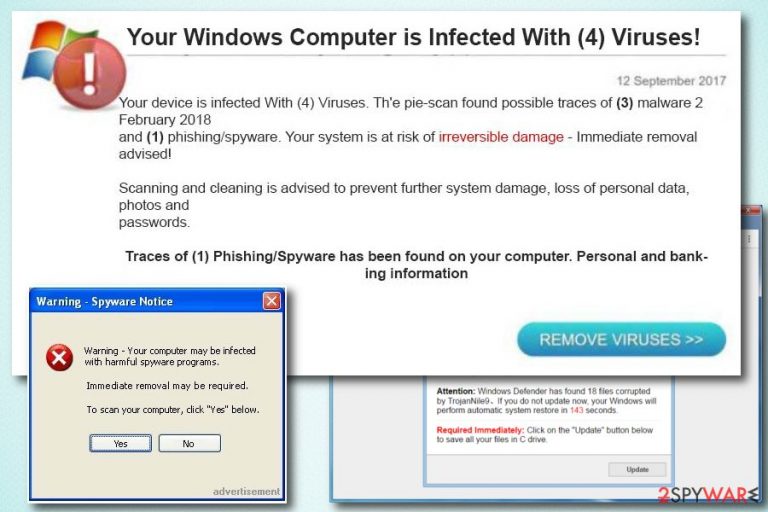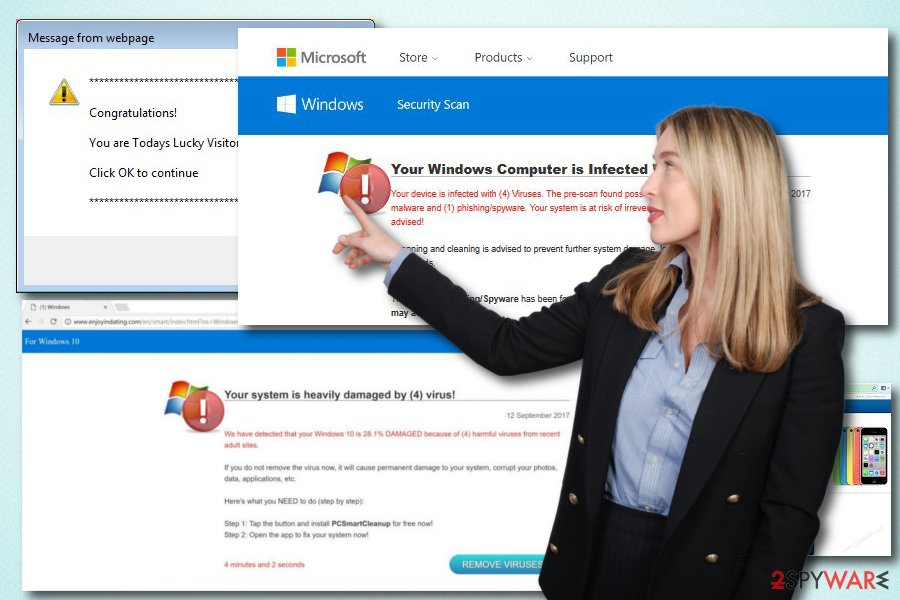Your Windows Computer Is Infected With (4) Viruses (Virus Removal Guide) - Free Instructions
Your Windows Computer Is Infected With (4) Viruses Removal Guide
What is Your Windows Computer Is Infected With (4) Viruses?
Your Windows Computer Is Infected With (4) Viruses is a fake alert that tries to trick users into installing bogus software

Your Windows Computer Is Infected With (4) Viruses is a scam created by cybercrooks to make users believe that their Windows machine is in danger because of multiple viruses affecting it. The goal of such messages is to scare users and make them download useless optimization tools that they do not need. This fake alert is almost identical to Your system is heavily damaged by (4) virus! and Four Virus and is probably created by same developers.
| SUMMARY | |
| Name | Your Windows Computer Is Infected With (4) Viruses |
|---|---|
| Type | Adware |
| Related fake alerts | Your system is heavily damaged by (4) virus!, Four Virus |
| Symptoms | Excessive spam of fake alerts, ads, pop-ups, deals, coupons, etc. |
| Main dangers | Malware infection, wasted money |
| Distribution | Software bundling |
| Elimination | Download and install FortectIntego; otherwise, check manual instructions below |
Users might encounter such fake pop-up after being redirected from a malicious site. However, individuals who come across these messages regularly most likely have an adware program installed on their computers.
Adware is ad-supported software and is considered to be a potentially unwanted program as it infiltrates users’ machines as an additional component in a software bundle. It is a well-known marketing technique which allows free software developers inject unwanted programs into unsuspecting users’ machines without adequately disclosing it.
The message reads the following:
Your Windows Computer is Infected With (4) Viruses!
Your device is infected with (4) Viruses. The pre-scan found possible traces of (3) malware and (1) phishing/spyware. Your system is at risk of irreversible damage – Immediate removal advised!
Scanning and cleaning is advised to prevent further system damage, loss of personal data, photos and passwords.
Traces of (1) Phishing/Spyware has been found on your computer. Personal and banking information may at risk.
As evident, crooks are using social engineering skills to make victims believe that their personal data, such as photos and passwords are at risk of being exposed. However, it is merely a trick, and none of these threats are real. Therefore, do not trust this fake alert and remove Your Windows Computer Is Infected With (4) Viruses from your machine.
Your Windows Computer Is Infected With Four Viruses removal can be performed using reliable security software, such as FortectIntego. Otherwise, you can check our manual removal instructions below this article.
Some users might proceed with the “repair.” If they click “Proceed” they will be shown another pop-up window stating more bogus information, such as virus name, a path of the file location, system information and similar data. Crooks then explain that the only way to fix these issues is by downloading fake security software, such as Advanced PC Fixer or PCSmartCleanup.
As we already mentioned, no viruses are affecting your machine, apart from adware. Still, it is a potential threat and should be eliminated ASAP.

Avoid unnecessary programs by installing software correctly
Research conducted by security experts reveals that most users are extremely careless when it comes to virtual safety. Therefore, adware and other PUP developers are quick to abuse that. They often employ software bundling to install their programs on multiple users' machines. Thus, it is essential to protect your computer from unwanted applications by being careful online.
When installing free software, remember to follow these simple guidelines:
- Do not rush the installation process and read instructions correctly;
- Do not press “Next” button without looking;
- Read through Terms and Conditions;
- When prompted, pick Advanced or Custom installation mode instead of Recommended/Quick one;
- When in Advanced/Custom settings, make sure you de-click all additional components that might be included together with the desired application.
Ways to delete Your Windows Computer Is Infected With (4) Viruses permanently
There are two different ways you can remove Your Windows Computer Is Infected With (4) Viruses virus from your computer. You can do it either manually or automatically.
If you are familiar with computers and its processes, you can perform manual Your Windows Computer Is Infected With (4) Viruses removal. For that, follow our guide below. However, we must warn you that incorrect execution might lead to permanent damage to system files and/or reinstallation of the virus.
The easiest way to get rid of Your Windows Computer Is Infected With (4) Viruses fake pop-ups is by downloading and installing a robust security tool. You can pick one from the list below, or select a program of your liking. Do not forget to bring it up to date before performing full computer scan.
You may remove virus damage with a help of FortectIntego. SpyHunter 5Combo Cleaner and Malwarebytes are recommended to detect potentially unwanted programs and viruses with all their files and registry entries that are related to them.
Getting rid of Your Windows Computer Is Infected With (4) Viruses. Follow these steps
Uninstall from Windows
To eliminate Your Windows Computer Is Infected With (4) Viruses fro m Windows, follow these guidelines:
Instructions for Windows 10/8 machines:
- Enter Control Panel into Windows search box and hit Enter or click on the search result.
- Under Programs, select Uninstall a program.

- From the list, find the entry of the suspicious program.
- Right-click on the application and select Uninstall.
- If User Account Control shows up, click Yes.
- Wait till uninstallation process is complete and click OK.

If you are Windows 7/XP user, proceed with the following instructions:
- Click on Windows Start > Control Panel located on the right pane (if you are Windows XP user, click on Add/Remove Programs).
- In Control Panel, select Programs > Uninstall a program.

- Pick the unwanted application by clicking on it once.
- At the top, click Uninstall/Change.
- In the confirmation prompt, pick Yes.
- Click OK once the removal process is finished.
Delete from macOS
Remove items from Applications folder:
- From the menu bar, select Go > Applications.
- In the Applications folder, look for all related entries.
- Click on the app and drag it to Trash (or right-click and pick Move to Trash)

To fully remove an unwanted app, you need to access Application Support, LaunchAgents, and LaunchDaemons folders and delete relevant files:
- Select Go > Go to Folder.
- Enter /Library/Application Support and click Go or press Enter.
- In the Application Support folder, look for any dubious entries and then delete them.
- Now enter /Library/LaunchAgents and /Library/LaunchDaemons folders the same way and terminate all the related .plist files.

Remove from Microsoft Edge
Delete unwanted extensions from MS Edge:
- Select Menu (three horizontal dots at the top-right of the browser window) and pick Extensions.
- From the list, pick the extension and click on the Gear icon.
- Click on Uninstall at the bottom.

Clear cookies and other browser data:
- Click on the Menu (three horizontal dots at the top-right of the browser window) and select Privacy & security.
- Under Clear browsing data, pick Choose what to clear.
- Select everything (apart from passwords, although you might want to include Media licenses as well, if applicable) and click on Clear.

Restore new tab and homepage settings:
- Click the menu icon and choose Settings.
- Then find On startup section.
- Click Disable if you found any suspicious domain.
Reset MS Edge if the above steps did not work:
- Press on Ctrl + Shift + Esc to open Task Manager.
- Click on More details arrow at the bottom of the window.
- Select Details tab.
- Now scroll down and locate every entry with Microsoft Edge name in it. Right-click on each of them and select End Task to stop MS Edge from running.

If this solution failed to help you, you need to use an advanced Edge reset method. Note that you need to backup your data before proceeding.
- Find the following folder on your computer: C:\\Users\\%username%\\AppData\\Local\\Packages\\Microsoft.MicrosoftEdge_8wekyb3d8bbwe.
- Press Ctrl + A on your keyboard to select all folders.
- Right-click on them and pick Delete

- Now right-click on the Start button and pick Windows PowerShell (Admin).
- When the new window opens, copy and paste the following command, and then press Enter:
Get-AppXPackage -AllUsers -Name Microsoft.MicrosoftEdge | Foreach {Add-AppxPackage -DisableDevelopmentMode -Register “$($_.InstallLocation)\\AppXManifest.xml” -Verbose

Instructions for Chromium-based Edge
Delete extensions from MS Edge (Chromium):
- Open Edge and click select Settings > Extensions.
- Delete unwanted extensions by clicking Remove.

Clear cache and site data:
- Click on Menu and go to Settings.
- Select Privacy, search and services.
- Under Clear browsing data, pick Choose what to clear.
- Under Time range, pick All time.
- Select Clear now.

Reset Chromium-based MS Edge:
- Click on Menu and select Settings.
- On the left side, pick Reset settings.
- Select Restore settings to their default values.
- Confirm with Reset.

Remove from Mozilla Firefox (FF)
Reset your Firefox browser by following these steps:
Remove dangerous extensions:
- Open Mozilla Firefox browser and click on the Menu (three horizontal lines at the top-right of the window).
- Select Add-ons.
- In here, select unwanted plugin and click Remove.

Reset the homepage:
- Click three horizontal lines at the top right corner to open the menu.
- Choose Options.
- Under Home options, enter your preferred site that will open every time you newly open the Mozilla Firefox.
Clear cookies and site data:
- Click Menu and pick Settings.
- Go to Privacy & Security section.
- Scroll down to locate Cookies and Site Data.
- Click on Clear Data…
- Select Cookies and Site Data, as well as Cached Web Content and press Clear.

Reset Mozilla Firefox
If clearing the browser as explained above did not help, reset Mozilla Firefox:
- Open Mozilla Firefox browser and click the Menu.
- Go to Help and then choose Troubleshooting Information.

- Under Give Firefox a tune up section, click on Refresh Firefox…
- Once the pop-up shows up, confirm the action by pressing on Refresh Firefox.

Remove from Google Chrome
Delete malicious extensions from Google Chrome:
- Open Google Chrome, click on the Menu (three vertical dots at the top-right corner) and select More tools > Extensions.
- In the newly opened window, you will see all the installed extensions. Uninstall all the suspicious plugins that might be related to the unwanted program by clicking Remove.

Clear cache and web data from Chrome:
- Click on Menu and pick Settings.
- Under Privacy and security, select Clear browsing data.
- Select Browsing history, Cookies and other site data, as well as Cached images and files.
- Click Clear data.

Change your homepage:
- Click menu and choose Settings.
- Look for a suspicious site in the On startup section.
- Click on Open a specific or set of pages and click on three dots to find the Remove option.
Reset Google Chrome:
If the previous methods did not help you, reset Google Chrome to eliminate all the unwanted components:
- Click on Menu and select Settings.
- In the Settings, scroll down and click Advanced.
- Scroll down and locate Reset and clean up section.
- Now click Restore settings to their original defaults.
- Confirm with Reset settings.

Delete from Safari
Remove unwanted extensions from Safari:
- Click Safari > Preferences…
- In the new window, pick Extensions.
- Select the unwanted extension and select Uninstall.

Clear cookies and other website data from Safari:
- Click Safari > Clear History…
- From the drop-down menu under Clear, pick all history.
- Confirm with Clear History.

Reset Safari if the above-mentioned steps did not help you:
- Click Safari > Preferences…
- Go to Advanced tab.
- Tick the Show Develop menu in menu bar.
- From the menu bar, click Develop, and then select Empty Caches.

After uninstalling this potentially unwanted program (PUP) and fixing each of your web browsers, we recommend you to scan your PC system with a reputable anti-spyware. This will help you to get rid of Your Windows Computer Is Infected With (4) Viruses registry traces and will also identify related parasites or possible malware infections on your computer. For that you can use our top-rated malware remover: FortectIntego, SpyHunter 5Combo Cleaner or Malwarebytes.
How to prevent from getting adware
Protect your privacy – employ a VPN
There are several ways how to make your online time more private – you can access an incognito tab. However, there is no secret that even in this mode, you are tracked for advertising purposes. There is a way to add an extra layer of protection and create a completely anonymous web browsing practice with the help of Private Internet Access VPN. This software reroutes traffic through different servers, thus leaving your IP address and geolocation in disguise. Besides, it is based on a strict no-log policy, meaning that no data will be recorded, leaked, and available for both first and third parties. The combination of a secure web browser and Private Internet Access VPN will let you browse the Internet without a feeling of being spied or targeted by criminals.
No backups? No problem. Use a data recovery tool
If you wonder how data loss can occur, you should not look any further for answers – human errors, malware attacks, hardware failures, power cuts, natural disasters, or even simple negligence. In some cases, lost files are extremely important, and many straight out panic when such an unfortunate course of events happen. Due to this, you should always ensure that you prepare proper data backups on a regular basis.
If you were caught by surprise and did not have any backups to restore your files from, not everything is lost. Data Recovery Pro is one of the leading file recovery solutions you can find on the market – it is likely to restore even lost emails or data located on an external device.
